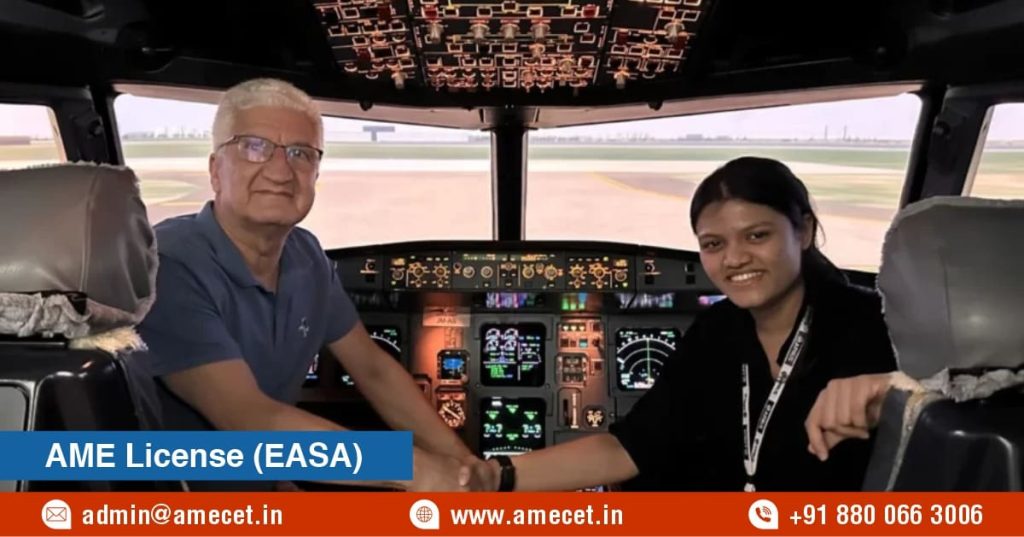What Is the EASA AME License?
Posted on : 22 July, 2024 6:11 pm
The EASA AME License, issued by the European Union Aviation Safety Agency (EASA), certifies individuals as Aircraft Maintenance Engineers within Europe. This license ensures that the holder is qualified to maintain and repair aircraft according to stringent European aviation safety standards. It involves rigorous training, examinations, and hands-on experience in aircraft maintenance. The EASA AME License is recognized internationally, providing opportunities for engineers to work with airlines, maintenance organizations, and aviation companies across the globe. Holding this license signifies a high level of expertise and commitment to aviation safety and quality.
Page Contents
ToggleEligibility Requirements
To obtain an EASA AME License, candidates must meet specific eligibility criteria. These include being at least 18 years old, having a high school diploma or equivalent, and passing a Class 2 medical examination. Applicants must also complete an EASA-approved training program, accumulate required practical maintenance experience, and pass written and practical exams. Proficiency in English and a clean background check are also necessary.
Eligibility Requirements:
- Minimum Age: At least 18 years old.
- Educational Qualification: High school diploma or equivalent.
- Medical Examination: Pass a Class 2 medical exam.
- Approved Training Program: Complete an EASA-approved course.
- Practical Experience: Accumulate required maintenance hours.
- Written Exams: Pass theoretical knowledge tests.
- Practical Exams: Successfully complete practical assessments.
- English Proficiency: Demonstrate proficiency in English.
Training and Education
Obtaining an EASA AME License requires rigorous training and education. Candidates must complete an EASA-approved training program, which includes both theoretical coursework and practical hands-on experience. The curriculum covers aircraft systems, maintenance practices, and safety regulations. Additionally, candidates must participate in internships or apprenticeships to gain real-world experience. Continuous learning and staying updated with technological advancements are also emphasized throughout the training.
Training and Education:
- Approved Training Program: Complete an EASA-certified course.
- Theoretical Coursework: Study aircraft systems and maintenance practices.
- Practical Experience: Hands-on training with real aircraft.
- Safety Regulations: Learn and adhere to aviation safety standards.
- Internships/Apprenticeships: Gain real-world experience.
- Continuous Learning: Ongoing education in the field.
- Technological Advancements: Stay updated with new technologies.
- Comprehensive Curriculum: Covering all essential aspects of aircraft maintenance.
Examinations and Certifications
To obtain the EASA AME License, candidates must pass rigorous examinations and obtain certifications. This includes comprehensive written exams covering theoretical knowledge of aircraft systems, maintenance, and regulations. Practical exams assess hands-on skills and ability to perform maintenance tasks. Candidates must also complete on-the-job assessments. Successful completion of these exams leads to certification by EASA, validating the engineer’s qualifications and expertise in aircraft maintenance.
Examinations and Certifications:
- Written Exams: Test theoretical knowledge of aircraft systems.
- Practical Exams: Assess hands-on maintenance skills.
- On-the-Job Assessments: Evaluate real-world performance.
- EASA Certification: Official recognition of qualifications.
- Maintenance Tasks: Demonstrate proficiency in various tasks.
- Regulations Knowledge: Understanding of safety and compliance standards.
- Skill Verification: Confirm expertise through exams.
- Continuous Assessment: Ongoing evaluation during training.
Skills and Knowledge Acquired
Earning an EASA AME License equips engineers with essential skills and knowledge for aircraft maintenance. They gain proficiency in diagnosing and repairing aircraft systems, understanding complex avionics, and ensuring compliance with safety regulations. Training includes hands-on experience with advanced tools and technologies. Additionally, engineers develop problem-solving abilities, attention to detail, and a commitment to continuous learning to stay updated with the latest advancements in aviation maintenance.
Skills and Knowledge Acquired:
- Diagnostic Skills: Identifying and fixing issues.
- Aircraft Systems: Understanding mechanical and electrical systems.
- Avionics: Knowledge of complex electronic systems.
- Safety Compliance: Adhering to aviation regulations.
- Advanced Tools: Using modern maintenance equipment.
- Problem-Solving: Effective troubleshooting techniques.
- Attention to Detail: Precision in maintenance tasks.
- Continuous Learning: Staying updated with industry advancements.
Regulations and Compliance
Aircraft Maintenance Engineers with an EASA license must adhere to strict regulations and compliance standards set by the European Union Aviation Safety Agency. This includes following maintenance protocols, conducting thorough inspections, and keeping detailed records. Engineers must stay updated with regulatory changes, ensuring all work meets safety and quality standards. Compliance with these regulations is crucial to maintaining the airworthiness and safety of aircraft, protecting passengers and crew.
Regulations and Compliance:
- EASA Standards: Adhering to regulations set by EASA.
- Maintenance Protocols: Following established procedures.
- Inspections: Conducting thorough and regular checks.
- Record Keeping: Maintaining detailed maintenance logs.
- Regulatory Updates: Staying informed on changes.
- Safety Standards: Ensuring all work meets safety requirements.
- Quality Assurance: Maintaining high-quality maintenance.
- Airworthiness: Ensuring aircraft safety and functionality.

